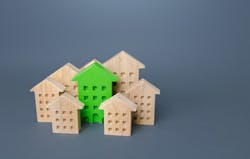Risks to Consider in the Race to Net Zero
The race to net zero in the residential construction industry is in full swing, and as a growing number of states adopt renewable energy policies and announce plans to use zero energy codes in upcoming construction projects, industry leaders also must consider the risks that accompany high-performance home building, says Green Builder.
In cold climates, less thermal and airflow to the inside surface of a high-performance construction assembly could lead to excess moisture buildup on the exterior wall sheathing, and in warm climates, moisture poses a risk to the inside surface of interior drywall. Ultra-low HVAC loads can also create a comfort risk in zero energy homes, and ultra-airtight structures could potentially trap contaminants within the home, reducing indoor air quality if proper ventilation is not achieved.
The best recommendations for ensuring good indoor air quality are to certify all homes to the EPA’s Indoor airPLUS program, along with educating homebuyers about effective behaviors for healthy living (e.g., using kitchen exhaust fan when cooking, using bathroom exhaust fan when bathing, taking shoes off at the entrance, vacuuming carpets regularly, checking furnishings for dangerous fire retardants, and cleaning gutters).
For more risks and construction tips …
